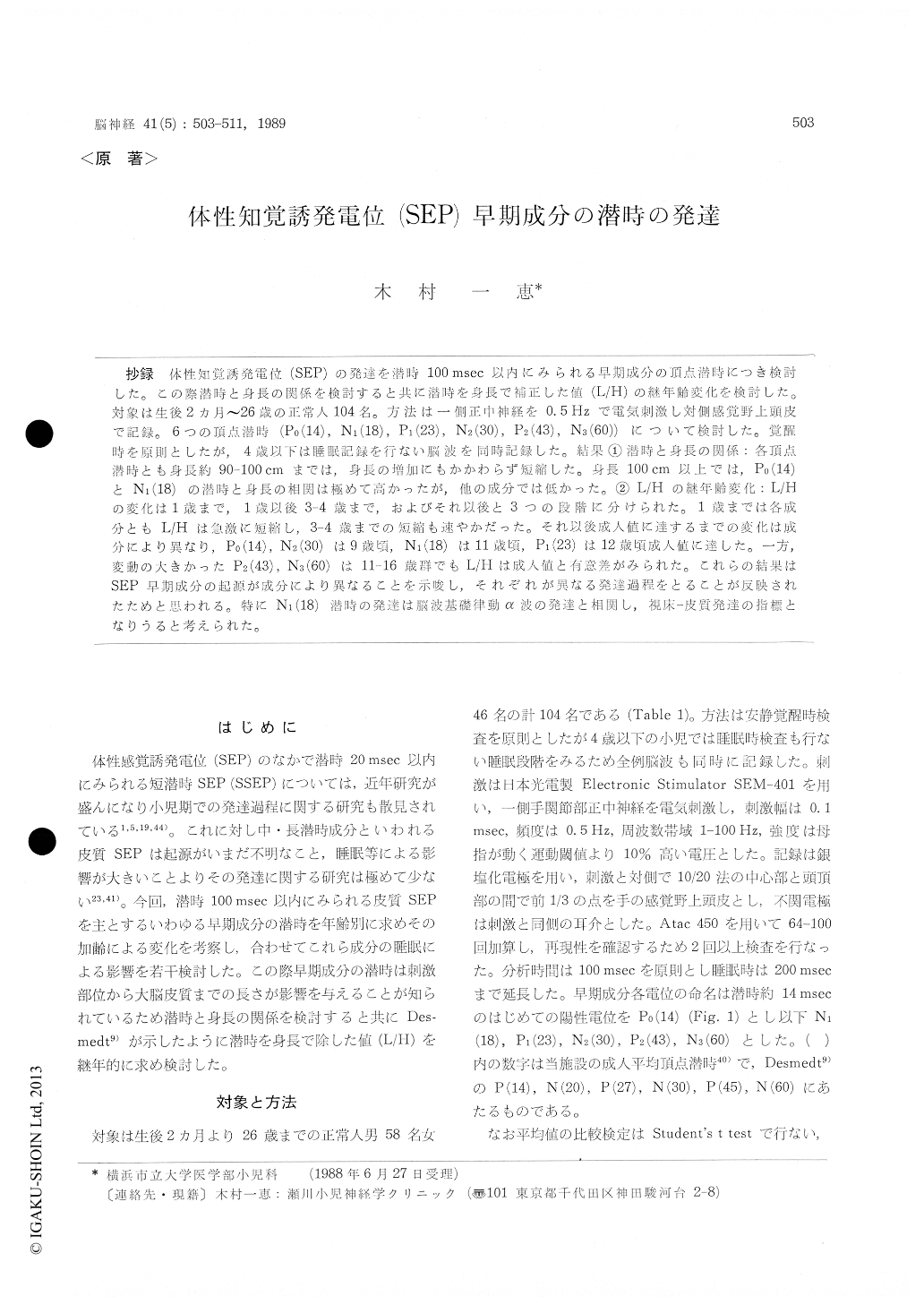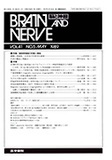Japanese
English
- 有料閲覧
- Abstract 文献概要
- 1ページ目 Look Inside
抄録 体性知覚誘発電位(SEP)の発達を潜時100 msec以内にみられる早期成分の頂点潜時につき検討した。この際潜時と身長の関係を検討すると共に潜時を身長で補正した値(L/H)の継年齢変化を検討した。対象は生後2カ月〜26歳の正常人104名。方法は一側正中神経を0.5Hzで電気刺激し対側感覚野上頭皮で記録。6つの頂点潜時(P0(14), N1(18), P1(23), N2(30), P2(43), N3(60))について検討した。覚醒時を原則としたが,4歳以下は睡眠記録を行ない脳波を同時記録した。結果①潜時と身長の関係:各頂点潜時とも身長約90-100cmまでは,身長の増加にもかかわらず短縮した。身長100cm以上では,P0(14)とN1(18)の潜時と身長の相関は極めて高かったが,他の成分では低かった。②L/Hの継年齢変化:L/Hの変化は1歳まで,1歳以後3-4歳まで,およびそれ以後と3つの段階に分けられた。1歳までは各成分ともL/Hは急激に短縮し,3-4歳までの短縮も速やかだった。それ以後成人値に達するまでの変化は成分により異なり,P0(14), N2(30)は9歳頃,N1(18)は11歳頃,P1(23)は12歳頃成人値に達した。一方,変動の大きかったP2(43), N3(60)は11-16歳群でもL/Hは成人値と有意差がみられた。これらの結果はSEP早期成分の起源が成分により異なることを示唆し,それぞれが異なる発達過程をとることが反映されたためと思われる。特にN1(18)潜時の発達は脳波基礎律動α波の発達と相関し,視床‐皮質発達の指標となりうると考えられた。
Development of early SEP components was stu-died, particularly in reference to the peak latency. Two factors were evaluated in the growing child-ren.
One was the correlation between latency and height and the other was the chronological change of latency divided by height (L/H).
One hundred and four normal subjects ranging in age from 2 months to 26 years were studied in the awake state except those under 4 years of age. EEG was also examined in every case.
The electrical stimulation was delivered every two seconds to the median nerve at wrist. Six com-ponents [Po(14) , N1(18), P1(23) , N2(30) , P2(43) N3(60)] were recognized in the contralateral Post-Rolandic area.
Results were as follows.
1) Correlation between latency and height : Every peak latency was shortened in cases with height up to around 90-100 cm. With height over 100 cm, a highly significant correlation was ob-served in Po(14). and N1(18), but not in the other components.
2) Chronological change of L/H : The change of L/H revealed 3 different stages ; by 1 year, by 3 to 4 years of age and thereafter. By 1 year, L/ H was markedly shortened in every SEP com-ponent. Another rapid decrease occurred by 3 to 4 years of age. Thereafter, changes to reach the adult level were different from each other.
L/H of Po(14) and N2(30) reached the adult level by around 9 years and N1(18) by around 11 years, P1(23) by around 12 years of age. While UPI of P2(43) and N3(60), more variable, still showed a significant difference from that of the adult level. 3) Effect of sleep : The change of N1(18) latency during awake state and sleep was only within 2.4% in stage 2 and 7. 5% in stage 3.
In conclusion, the maturational difference of each SEP component suggested to reflect a different in-dividual development for each origin.
Developmental change of N1(18) was consistent with the matturation of the basic activity of the electroencephalogram, a wave and could be con-sidered one of the maturational indices of the thalamo-cortical system.

Copyright © 1989, Igaku-Shoin Ltd. All rights reserved.


